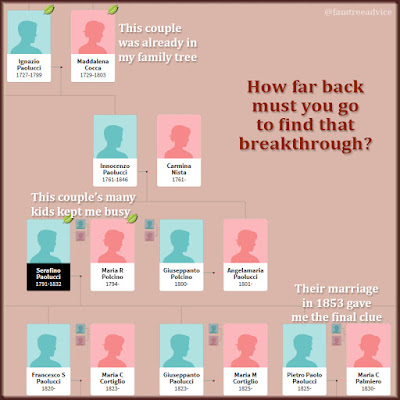Knowing what you want from your genealogy research can keep you on track.
Imagine a world…where time stands still and you can research your family tree for as long as you please.
Yeah. That's not gonna happen.
Since your genealogy research time is limited, you need to make the most of it. If you stick to your top priorities, you can make the most progress.
| Let your priorities keep you on the path you want to take. |
Here's an example of what I mean. There's a celebrity whose ancestors came from my grandfather's hometown in Italy. I'd known about her link to the town for years.
But a new lead gave me the names of the celebrity's great grandparents: Francesco diPaola and Libera Antonia Marino. And the fact that they emigrated to the USA.
It turns out her great grandparents were in my family tree! Better yet, her great grandfather was the grandson of my 4th great grandparents. If things worked out, and she and I shared this set of 4th great grandparents, we'd be 5th cousins.
That's what I needed to prove. I had to find a line from this immigrant couple to the celebrity. I turned to Ancestry.com for U.S. records. I found Francesco diPaola's 1903 immigration record. He was still single when he came here.
I pressed on. I went first to the family's 1940 census. I figured the celebrity's grandparent was most likely to be there as a child.
Logically, since the celebrity's maiden name is not diPaola, she should be the granddaughter of one of the diPaola girls. There were 2 girls in the family on this 1940 census. I picked one. I searched for any record that might show she married a man with the same last name as the celebrity.
And I found it. The elder diPaola daughter's U.S. Social Security Application and Claims Index shows her maiden name, diPaola, and her married name. It matches the name of the celebrity. Based on that alone, I attached the celebrity's father to this diPaola daughter. (I found his name on Wikipedia.)
That made the celebrity my 5th cousin.
But I kept going. I wanted to find the other documents for the family. I discovered that Libera, the celebrity's great grandmother, came to America in 1899 to join her father. Her father Giorgio Marino was in the same U.S. town Francesco diPaola went to in 1903.
That means this Italian couple, born in the same town, reconnected and married in Pennsylvania. The Marino family then joined the diPaola family and moved from Pennsylvania to Michigan.
Then I found that an older daughter, not in the 1940 census, had also married a man with the celebrity's maiden name. Maybe she was the celebrity's grandmother!
An obituary would help me decide which sister is the celebrity's grandmother. So far I haven't found one. I'd like to get it right, of course. But either way, I do know the celebrity is my 5th cousin. That was the game I was playing.
More than once during this genealogy session I had to rein myself in. Did I really want to spend so much time following Francesco and Libera's many, many children? Not really.
That's when I thought about my priorities. Focusing on my priorities, I decided to leave the descendants alone for now. I'd found almost every possible U.S. record for them. But the couple's siblings in Italy were more important to me.
My Priority One is always the 19th-century Italians from my ancestral hometowns. I want to strengthen that part of my family tree and make it as complete as possible. I have 1,000s of vital records from my towns sitting on my computer. Nearly every person in those documents is connected to me. My passion is to piece them all together.
Yes, it would be great to find out where all the Italian emigrants wound up later in life. But that's not my priority.
 |
| In a rare case of peeking at someone else's tree, I got the leg-up I needed. |
So I returned to their ancestors. I knew the names of Francesco diPaola's parents, but I couldn't find their documents. A peek at someone else's family tree helped me narrow down their birth years. Eventually, I found them!
Now I'm looking through their family's facts. What am I missing? Where should I look for it? Can I add more generations?
My priorities set me back on the track that's most important to me.
What's your top priority? Is it to:
- document your closest family members?
- locate the living descendants of your ancestor's siblings?
- find your earliest recorded ancestor?
- figure out your connection to your DNA matches?
- spread your tree out as wide as you can?
Whatever is most important to you, let it guide you. When research time is limited, let your top priority set you on the path toward that goal.
Diversions can be really fun. I've gone way out on distant limbs of my family tree just because I could. But in the end, I want my family tree to be a rock-solid, well-documented snapshot of my ancestral hometowns.
Now it's time to get back to it.
More about Priorities and Genealogy Goals:





